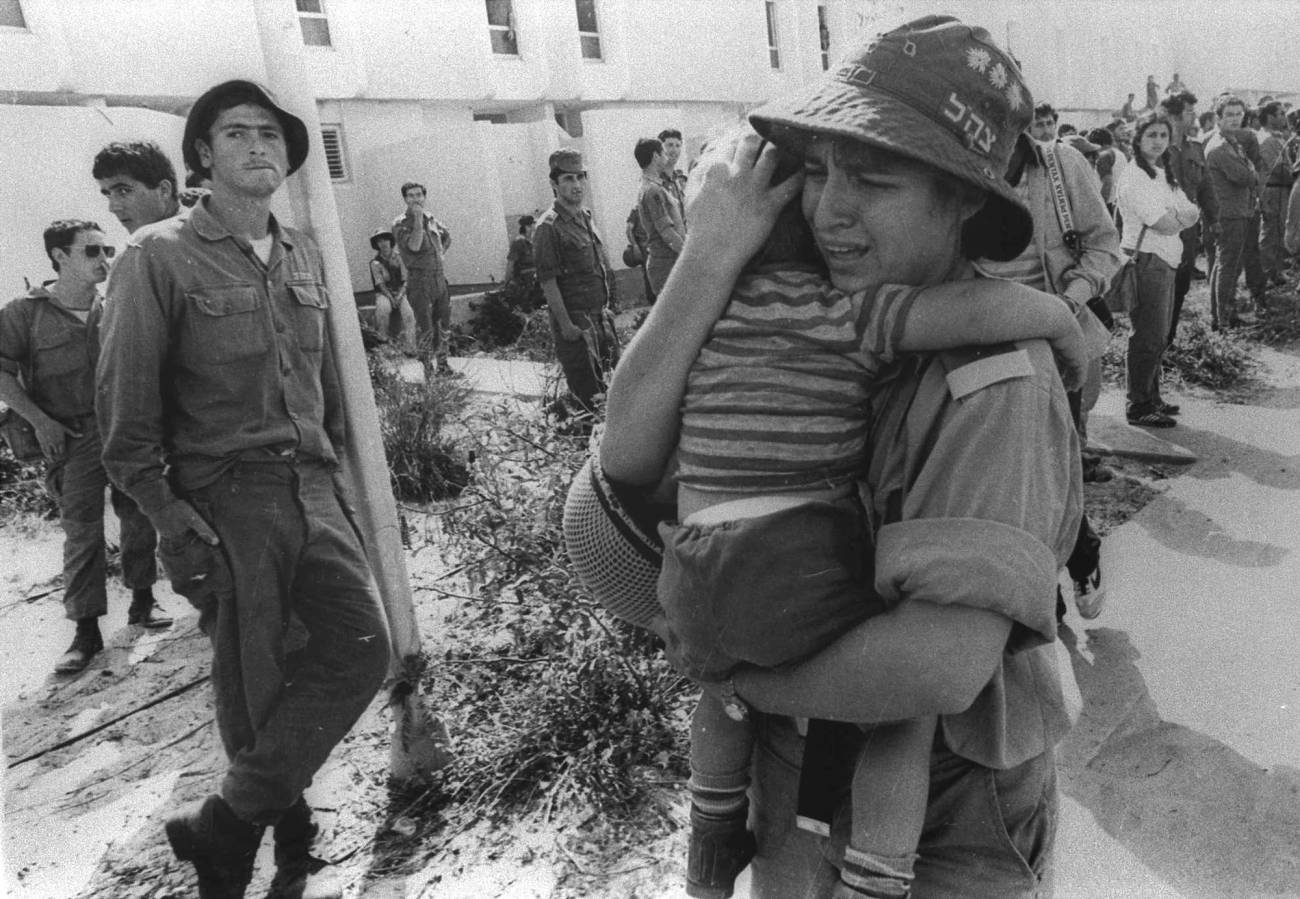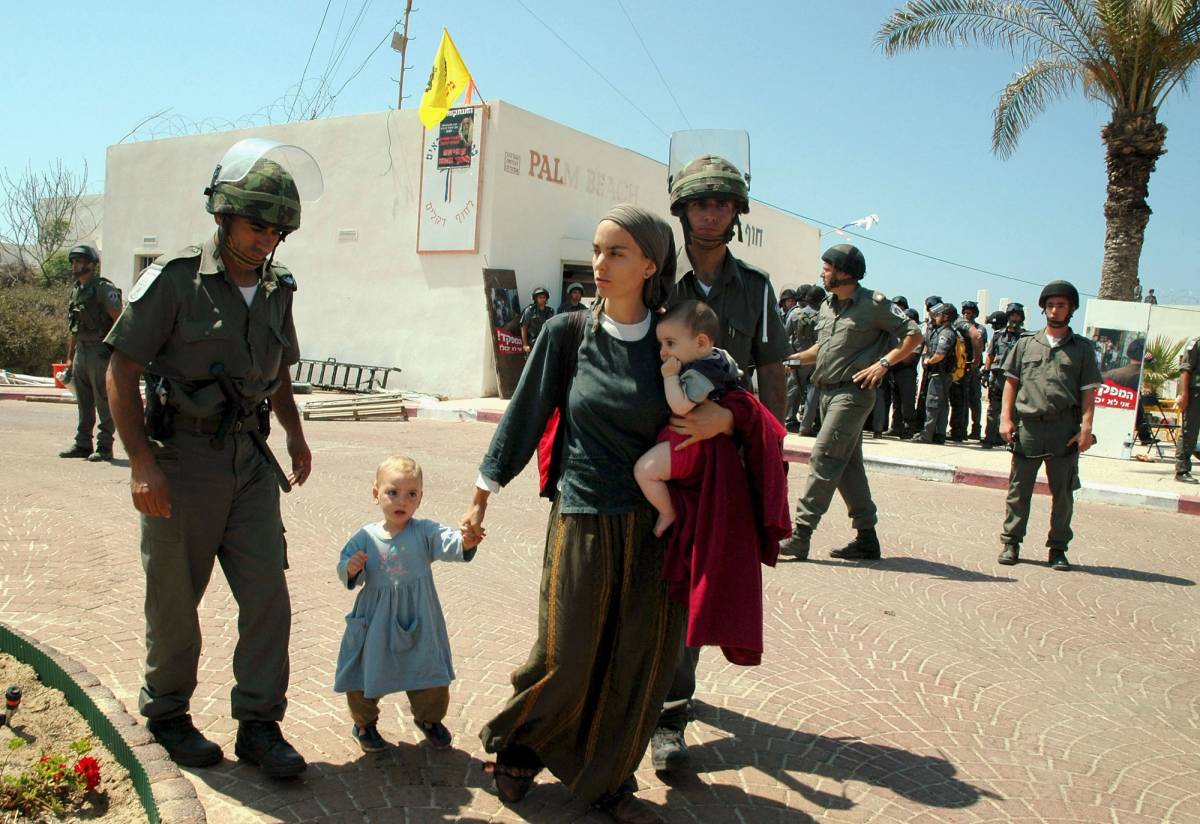A Second Exile
For Israelis who previously evacuated their homes in Sinai or Gaza, leaving their new homes in northern and southern Israel during the current war against Hamas feels like déjà vu

Miki Tzarfati/GPO/Getty Images

Miki Tzarfati/GPO/Getty Images

Miki Tzarfati/GPO/Getty Images
For over a quarter-million Israelis, Oct. 7 didn’t only signal the start of a war. It was also the day they realized they’d have to leave their homes. Some of them had a sense of déjà vu. They had been exiled from their homes before.
For Pnina Rogolsky, this evacuation brought back memories of the spring of 1982, when she lost her home in southern Sinai after Israel signed a peace treaty with Egypt.
Dreaming of a quiet agrarian life, Rogolsky and her husband had moved to the Yamit settlement bloc in the early 1970s in response to a government call to settle the Sinai, which had come under Israeli control after the Six-Day War in 1967. They joined a brand new moshav near Yamit called Netiv HaAsara.
“The Jewish Agency gave us a tract of land and a tractor, which we shared with another family,” Rogolsky told me. “We grew tomatoes, mangoes, and flowers. I had my first baby. We were all young. We helped each other out. We socialized. It was a good life.”
She didn’t expect it all to end, and certainly not so quickly. “When the talk started about a peace treaty with Egypt, we assumed that we’d remain in our homes,” she said. “We didn’t think we’d give back Sinai.”
Initially, Rogolsky and the other Sinai settlers fought the plan. “We lobbied Knesset members, we demonstrated, we even burned tires,” she recalled. But by the spring of 1982, she said, the battle was lost: “We left our moshav in a caravan with our lights on as if we were on the way to a funeral.”
Rogolsky and her family—along with the other 70 families who evacuated the moshav in the Sinai—helped to reestablish the moshav, also called Netiv HaAsara, in what they hoped was a more secure location just outside the Gaza Strip.
Starting again wasn’t easy. “Losing our moshav in the Sinai felt like losing a limb,” said Rogolsky. “Some of our people could barely function.” But Rogolsky, who was then in her 30s, felt compelled to pull herself together. “Working the land helped me to heal,” she said.
Then came the Hamas attack on Oct. 7, when terrorists killed 20 members of the moshav. Rogolsky and her husband were in another part of the country visiting friends, but her son was at the moshav leading the security team. Fortunately he survived the attack. Rogolsky has been back several times since Oct. 7 “to visit and to do laundry,” she said; her husband goes back more frequently to tend to the family’s chicken coop. But neither of them stays for long.
Netiv HaAsara is in its second exile, its 900 residents scattered in hotels and apartments throughout central Israel. Rogolsky lives in the Yearim Hotel in the Judean Hills just outside of Jerusalem with several dozen of her neighbors, most of them like herself in their 70s and 80s, but it’s far from ideal.
The first days were the hardest, she said: “That whole first week we went from funeral to funeral, shiva to shiva.”
Once again, Rogolsky has found comfort in work. Instead of farming, she helped to set up a program of activities at her hotel. “We play bridge. We do yoga and pilates. We go on trips. We keep ourselves busy,” she said.
As for returning to the moshav, Rogolsky is dubious: “Everything we built over 40 years seems like it’s going to vanish. We need a lot of strength and help to return to normal life. We aren’t living a normal life.”
Being younger doesn’t necessarily make the transition easier. For Raaya Manshari and Hila Buskila—both 30-somethings and both former Gaza envelope residents now relocated to Jerusalem-area hotels—Oct. 7 brings back memories of a more recent evacuation: the 2005 disengagement when the Israeli government relinquished control of Gaza and dismantled the settlements of Gush Katif.
Manshari, a kindergarten teacher, was 16 when her family left the Gush Katif town of Atzmona. Buskila, a social worker and stylist, was a young bride with a new baby when her family had to leave their home in Nisanit. Even now, both still mourn the charmed lives they remember having in Gaza. “Our lives were so good that we never believed it would end,” said Manshari.

Shaul Schwarz/Getty Images
Both remember holding out until the last possible moment, not wanting to leave. “We didn’t think it would happen,” recalled Buskila. “We were expecting a miracle.”
Although the 2005 Gaza disengagement was marked by loud protest, which nearly slid into violence, both women left their homes peacefully.
“We allowed the soldiers into our homes. We prayed with them. We recited psalms together,” said Buskila. “They helped us to take down our mezuzahs, and they helped us to pack.”
Even after they closed their doors, they hoped that their departure would be temporary. “We packed only for a few days,” said Manshari. “We were convinced that the government’s decision was so illogical that they would walk it back.”
Like Rogolsky, the Gush Katif evacuees found the first days the most challenging. “We did a lot of crying” recalled Manshari, noting that even after the tears had dried, they struggled: “It took us a long time to find our place. We were always looking for Atzmona.”
Manshari married a man from Gush Katif and moved to Moshav Shlomit in the Gaza envelope because it shared Atzmona’s sandy landscape. “In place of the sea, however, there was Gaza,” she noted. Buskila moved to Moshav Shokeida, 31 miles away from Manshari’s moshav.
On the morning of Oct. 7, both women awoke to the sound of guns and missile fire. They had heard missile fire before—the Gaza envelope had suffered hundreds of missile attacks—but this was different.
“The booms were louder than anything I ever heard,” said Manshari. While her husband left to fight the terrorists, Manshari barricaded herself in her safe room together with her four children. “We played games, we ate sweets, and we recited psalms.”
Buskila also spent the day in her safe room with her children while her husband kept watch from the roof of their home. Miraculously, the terrorists skipped over their moshavim. Nevertheless, war had started, and the following day they were ordered to evacuate.
“We had 10 minutes to get ready,” Manshari said. “I thought we’d be gone for two or three days. That’s how I packed.”
“We didn’t know where we were going or for how long,” said Buskila.
Both women joined their neighbors driving out in a convoy. Still, the journey was terrifying. The road had yet to be cleared from the debris of the massacre. “We saw dead bodies and burned-out cars,” said Buskila. “It was hard to see.”
Even with a military escort, it wasn’t clear that the road was safe. “I was afraid that the terrorists would shoot at us as we left,” said Manshari.
Both women joined residents of their respective moshavim at field schools in central Israel. Both reported that they were well treated. “People brought us whatever we needed,” said Buskila.
Still, the experience hurts, said Manshari: “I feel like a leaf that had fallen off of a tree.”
Buskila says that she’s found relief by talking to other members of her community: “Everyone told their story of Oct. 7,” she said. “I think that really helped us.”
Like Rogolsky, Buskila and Manshari now live in hotels in the Judean Hills outside of Jerusalem.
“The hotel looks after us very well, but I feel like I’m in a golden cage,” said Manshari. “It’s noisy. And there’s no privacy.”
Gaza envelope residents have been going back to visit. Buskila reports that she and some of her neighbors have returned for overnight stays and even for Shabbat, but not more than that.
“We want to go back to our lives, to heal from Oct. 7,” Buskila said. “Our communities are not livable. Schools aren’t open. And you hear constant noises of war.”
It’s likely that many months will pass before they go home. Recently, Prime Minister Netanyahu and the IDF spokesman have stated that the war will continue through 2024.
While all three women strongly support the war, they blame Israeli government policies, particularly the 2005 disengagement, as the reasons for their present predicament. “The disengagement allowed Hamas to build up,” said Buskila. “I believe it led us to Oct. 7.”
Rogolsky, who had once supported the Gaza withdrawal, concurs: “We thought having the army out of the Gaza Strip would lead to peace. We got it back in our faces.”
Manshari expressed a tentative, albeit mystical, optimism. “It’s 19 years from the disengagement. It took us 19 years to liberate the Kotel and return it to Gush Etzion,” she said, referring to the period between Israel’s 1948 War of Independence and the Six-Day War in 1967. “Maybe this time we will free Gush Katif.”
Carol Ungar’s writing has appeared in Next Avenue, Forbes, NPR, the Jerusalem Post Magazine, and Fox News. She also leads memoir writing workshops on Zoom.